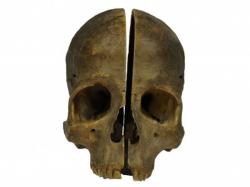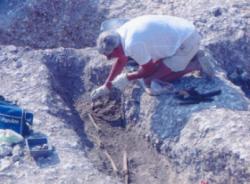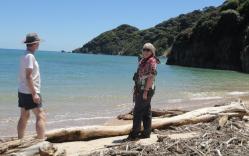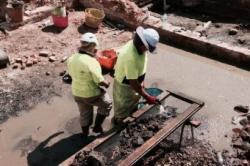INSTITUT SUPERIEUR D'ANTHROPOLOGIE
INSTITUTE OF ANTHROPOLOGY
ONLINE COURSES / COURS A DISTANCE
SPRING TERM : APRIL 2015
REGISTER NOW
ANTHROPOLOGIE –  Human dissection: It’s better than it used to be. That's the conclusion Jenna Dittmar of the University of Cambridge in the United Kingdom has come to after studying skeletons excavated from a hospital graveyard in England, as well as those stored by universities and medical museums. In a talk here today at the annual meeting of AAAS (which publishes Science), she described tracking the change in dissection practices between 1650 and 1900. The excavations often turn up lone limbs and skulls, long separated from the rest of the body, probably indicating that one cadaver would often have been split between many students. A dissectable body was a “very valuable resource,” because there weren’t that many of them around, Dittmar explained. In the early 1820s, for example, there would have been about 700 medical students in London needing to share 52 legally available cadavers. Dittmar uses scanning electron microscopes to examine the cut marks medical students and other dissectors left behind on the bones of their subjects. Those detailed images allow her to reconstruct the kinds of tools that were common at different times. Before 1700, surgical instruments were more like "woodworking tools" than the precision equipment used today, she said. Gradually, the saws got thinner and thinner, and the cuts more and more refined. Techniques improved along with the tools. For example, early dissectors simply sawed off the top of the skull horizontally, which often damaged the brain. But Dittmar found that beginning in the late 1880s, dissectors began cutting a delicate arc across the back of the skull, a technique that protected the fragile organ. Vertical cuts like the one seen on the skull pictured above were more rare and served more specific purposes. This specimen was found in the University of Cambridge’s collection and was likely used as a teaching tool in medical school classrooms.
Human dissection: It’s better than it used to be. That's the conclusion Jenna Dittmar of the University of Cambridge in the United Kingdom has come to after studying skeletons excavated from a hospital graveyard in England, as well as those stored by universities and medical museums. In a talk here today at the annual meeting of AAAS (which publishes Science), she described tracking the change in dissection practices between 1650 and 1900. The excavations often turn up lone limbs and skulls, long separated from the rest of the body, probably indicating that one cadaver would often have been split between many students. A dissectable body was a “very valuable resource,” because there weren’t that many of them around, Dittmar explained. In the early 1820s, for example, there would have been about 700 medical students in London needing to share 52 legally available cadavers. Dittmar uses scanning electron microscopes to examine the cut marks medical students and other dissectors left behind on the bones of their subjects. Those detailed images allow her to reconstruct the kinds of tools that were common at different times. Before 1700, surgical instruments were more like "woodworking tools" than the precision equipment used today, she said. Gradually, the saws got thinner and thinner, and the cuts more and more refined. Techniques improved along with the tools. For example, early dissectors simply sawed off the top of the skull horizontally, which often damaged the brain. But Dittmar found that beginning in the late 1880s, dissectors began cutting a delicate arc across the back of the skull, a technique that protected the fragile organ. Vertical cuts like the one seen on the skull pictured above were more rare and served more specific purposes. This specimen was found in the University of Cambridge’s collection and was likely used as a teaching tool in medical school classrooms.
http://news.sciencemag.org/archaeology/2015/02/skeletons-hospital-graveyard-shed-light-early-dissections
ROYAUME UNI –  Eastbourne - Eastbourne’s extensive early Anglo-Saxon cemetery and the discovery of an early Iron Age settlement were the subject of a talk by Patricia Stevens on Friday. In 1991 Patricia directed the excavations of Eastbourne’s early Anglo-Saxon cemetery and the discovery of an early Iron Age Settlement, undertaken for the Eastbourne Natural History and Archaeological Society. The area occupied the crest of St Anne’s Hill, where evidence of an early Iron Age settlement was discovered in 1989. Patricia described some of the 28 burials excavated as well as several cremations. Numerous knives, spears, beads, brooches and many other artefacts were recovered as well as Anglo-Saxon and Iron-Age pottery. Also, the site of a Bronze Age round barrow was revealed with its ditch. The Anglo Saxon cemetery and iron Age settlement sites have proved to be the largest of their kind in Eastbourne.
Eastbourne - Eastbourne’s extensive early Anglo-Saxon cemetery and the discovery of an early Iron Age settlement were the subject of a talk by Patricia Stevens on Friday. In 1991 Patricia directed the excavations of Eastbourne’s early Anglo-Saxon cemetery and the discovery of an early Iron Age Settlement, undertaken for the Eastbourne Natural History and Archaeological Society. The area occupied the crest of St Anne’s Hill, where evidence of an early Iron Age settlement was discovered in 1989. Patricia described some of the 28 burials excavated as well as several cremations. Numerous knives, spears, beads, brooches and many other artefacts were recovered as well as Anglo-Saxon and Iron-Age pottery. Also, the site of a Bronze Age round barrow was revealed with its ditch. The Anglo Saxon cemetery and iron Age settlement sites have proved to be the largest of their kind in Eastbourne.
http://www.eastbourneherald.co.uk/news/local/cemetery-gives-up-its-secrets-1-6579433
NOUVELLE ZELANDE –  Wainui Bay - Maritime history student Dr Rosanne Hawarden found more detail when she enlarged a high resolution scan of the first printed image of New Zealand and the Maori people during Abel Tasman's first visit to New Zealand in 1642. Embedded in one of the images and all but invisible to the naked eye are a dozen tiny canoes on beaches. This is the first printed image of Maori watercraft on land or at anchor. Dr Hawarden and independent scholar Rudiger Mack made several trips out to sea to find the exact place from which the original Dutch drawings were made. The canoe beaches can be identified in the landscape with two of them - Taupo Point and Takapou in Wainui Bay, which is part of Golden Bay in the South Island - being recorded archaeological sites.
Wainui Bay - Maritime history student Dr Rosanne Hawarden found more detail when she enlarged a high resolution scan of the first printed image of New Zealand and the Maori people during Abel Tasman's first visit to New Zealand in 1642. Embedded in one of the images and all but invisible to the naked eye are a dozen tiny canoes on beaches. This is the first printed image of Maori watercraft on land or at anchor. Dr Hawarden and independent scholar Rudiger Mack made several trips out to sea to find the exact place from which the original Dutch drawings were made. The canoe beaches can be identified in the landscape with two of them - Taupo Point and Takapou in Wainui Bay, which is part of Golden Bay in the South Island - being recorded archaeological sites.
http://www.radionz.co.nz/news/te-manu-korihi/266271/fresh-information-on-early-encounters?
AUSTRALIE –  Hobart - Coins, jewellery and horse saddle parts have been found under a former car park in inner city Hobart as part of an archaeological dig before construction work begins on student apartments.Old coins and jewellery have been unearthed, along with more unusual items including parts of leather horse saddles. The site is in one of the oldest areas of the southern capital, on the corner of Melville and Elizabeth streets. Researchers have uncovered structures from the late 1820s, including pub basements and the rear stables.
Hobart - Coins, jewellery and horse saddle parts have been found under a former car park in inner city Hobart as part of an archaeological dig before construction work begins on student apartments.Old coins and jewellery have been unearthed, along with more unusual items including parts of leather horse saddles. The site is in one of the oldest areas of the southern capital, on the corner of Melville and Elizabeth streets. Researchers have uncovered structures from the late 1820s, including pub basements and the rear stables.
http://www.abc.net.au/news/2015-02-16/horse-saddle-parts-unearthed-in-an-archaeological-dig-in-hobart/6117120?section=tas
CANADA – Montréal - Canadian real estate developer Ivanhoe Cambridge is suspending construction on a new Montreal office tower after a freelance photographer expressed concerns that the site could be an ancient aboriginal burial ground.Mr. Galbraith said he believes the construction area, known by its address at 900 de Maisonneuve Ouest, could be part of what historians have identified as the Dawson archeological site. Covering an estimated two acres and studied by then-McGill College director William Dawson in the late 1800s, it was an ancient aboriginal village with remains that included tools and human bones. Some people believe the site is actually Hochelaga, the St. Lawrence Iroquoian village visited by explorer Jacques Cartier in 1535, and later abandoned. But that has never been proven. Michael Bisson, an associate professor of anthropology at McGill University, said there is only about a 10-per-cent chance at best that even a few scraps of any ancient site remains. That’s because big row houses stood there in a more recent past, and digging the foundations for those homes would probably have destroyed what was there.
http://www.theglobeandmail.com/news/national/montreal-office-tower-site-may-be-an-aboriginal-burial-ground/article23010796/
BULGARIE – Varna - An ancient tomb has been discovered during repair works in the center of the Black Sea city of Varna. The repair teams stumbled upon the tomb on Thursday. Its approximate whereabouts had been known since the beginning of the 20th century, the Bulgarian National Television reports. Back then, it was briefly explored but sealed as construction was ongoing throughout Varna. Archaeologists say the object, lying on Nezavisimost Square between the city theater and the State Archive, was located beyond the walls of Odesos, the ancient city that was once situated where Varna is now. An option to start restoration and include the tomb into the square's landscape.
http://www.novinite.com/articles/165868/Ancient+Tomb+Discovered+in+Downtown+Varna?
INDE – Taj - ASI will soon issue a notification to bring three Mughal-era structures near the Taj under its protection, so these can also be conserved. The ruins of these structures will form part of the riverfront gardens. The three structures are Hathi Khana, Aga Khan haveli and Khan-e-Durran haveli, all on the left side of the Taj, on the banks of the Yamuna. Khan-e-Durran was Shah Jahan's governor in the Deccan, who played a significant role in the annexation of the Daulatabad Fort in 1633. His haveli was later converted into a tannery by the British. The ownership of the structure is presently under dispute. Aga Khan was superintendent (also faujdar) under Shah Jahan. He was assigned the task of maintenance of law and order at the river front. "He was also in charge of a thousand horses of the Mughal army. He died in 1658," an ASI official said. The Hathi Gate is a gateway, most likely the entry point to the area where the elephants were kept. Not much is known about this structure, which finds mention in Austrian historian of architecture and art Ebba Koch's book on monuments in this area. The Hathi Gate is also mentioned in the 17th century 'Padshahnama', authored by Abdul Hamid Lahori.
http://timesofindia.indiatimes.com/city/agra/ASI-to-take-over-3-Mughal-era-structures-near-Taj/articleshow/46266475.cms
BANGLADESH -  Tongibarhi Upazila - The Director of Archaeological Excavation and Research Project in Munshiganj’s Bikrampur, Nuh-ul-Alam Lenin, announced the discovery at a press conference at the site on Monday. The excavation at the site in Tongibarhi Upazila was conducted for two months under a joint initiative of Bangladesh and China. Research Director Prof Shah Sufi Mustafizur Rahman said they found two roads made of old bricks in ‘attractive architectural design’, a zigzag 2.75-metre wide wall and many other archaeological relics at the site. Mustafizur Rahman, who also teaches archaeology at Jahangirnagar University, said the discovery of the relics was the evidence of the existence of a ‘rich civilisation’ in Bikrampur in the past.
Tongibarhi Upazila - The Director of Archaeological Excavation and Research Project in Munshiganj’s Bikrampur, Nuh-ul-Alam Lenin, announced the discovery at a press conference at the site on Monday. The excavation at the site in Tongibarhi Upazila was conducted for two months under a joint initiative of Bangladesh and China. Research Director Prof Shah Sufi Mustafizur Rahman said they found two roads made of old bricks in ‘attractive architectural design’, a zigzag 2.75-metre wide wall and many other archaeological relics at the site. Mustafizur Rahman, who also teaches archaeology at Jahangirnagar University, said the discovery of the relics was the evidence of the existence of a ‘rich civilisation’ in Bikrampur in the past.
http://bdnews24.com/bangladesh/2015/02/16/thousand-year-old-buddhist-city-discovered-in-munshiganjs-nateshwar